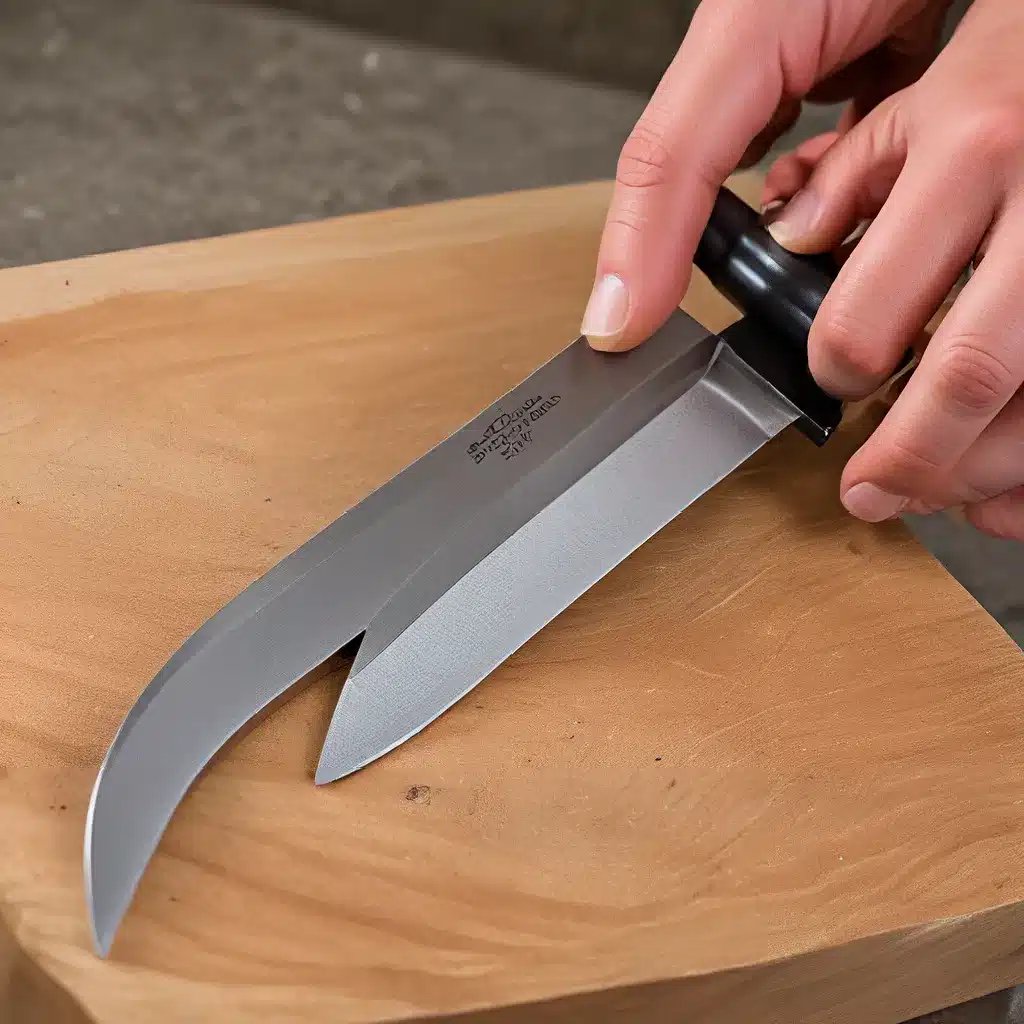
As a passionate knife enthusiast, I’ve always been fascinated by the art of knife grinding. There’s something truly mesmerizing about watching a skilled bladesmith transform a rough piece of steel into a razor-sharp, meticulously crafted tool. And at the heart of this process lies the all-important bevel – the carefully angled edge that not only determines the knife’s cutting performance but also its overall aesthetic.
Understanding the Bevel: The Key to Cutting Perfection
The bevel of a knife refers to the angled edge that’s ground into the blade. This angle is crucial, as it affects everything from the knife’s cutting ability to its durability and ease of sharpening. A well-executed bevel can make all the difference between a knife that glides through even the toughest materials with ease and one that struggles to maintain its edge.
Now, I know what you’re thinking – how hard can it be to grind a bevel, right? Well, my friend, let me tell you, it’s an art form that takes years of practice to truly master. But fear not, because I’m here to walk you through the essential knife grinding techniques that will have you creating perfect bevels in no time.
Mastering the Grinder: The Foundation of Bevel Precision
At the heart of the bevel-grinding process is the trusty belt grinder. This versatile tool is the backbone of any bladesmith’s workshop, allowing them to shape, thin, and refine the blade with unparalleled precision. But, as with any powerful tool, it’s important to understand its intricacies and learn how to wield it effectively.
One of the key factors to consider when using a belt grinder is the grit size of the abrasive belt. Lower grit belts (think 80-120 grit) are great for removing material quickly and shaping the overall blade profile, while higher grit belts (220-600 grit) are better suited for refining the bevel and achieving that mirror-like finish. It’s all about finding the right balance and knowing when to switch between grits to get the job done efficiently.
Another crucial aspect is maintaining the grinder’s alignment. Over time, the belt can start to drift or the platen (the flat surface the blade rests on) can become uneven, throwing off the angle of your bevel. By regularly checking and adjusting the grinder’s alignment, you can ensure that every pass of the blade results in a perfectly consistent bevel.
The Art of Bevel Grinding: Techniques for Precision and Consistency
Now that we’ve covered the foundation, let’s dive into the techniques that will help you achieve those showstopping bevels. One of the most important things to master is controlling the angle of the blade as it passes across the grinder. This not only determines the bevel angle itself but also ensures that the bevel is perfectly straight and free of any unwanted undulations or waves.
Experts suggest using a bevel gauge or angle jig to help maintain a consistent angle throughout the grinding process. These handy tools take the guesswork out of the equation and allow you to dial in the perfect bevel angle every time.
But angle control is only half the battle. You also need to develop a smooth, consistent technique for passing the blade across the grinder. This means minimizing any wobble or hesitation in your movements, as well as applying even pressure along the length of the blade. Some experienced grinders even recommend using a rocking motion to help create a seamless, continuous bevel.
And let’s not forget about cooling the blade. As you grind, the friction can quickly build up heat, which can affect the temper of the steel and even cause warping or discoloration. By quenching the blade in water or using a dedicated cooling system, you can keep things nice and cool, ensuring that your bevel stays perfectly straight and true.
Putting it All Together: Achieving the Perfect Bevel
Now, I know what you’re thinking – with all these techniques and considerations, how on earth am I supposed to create a flawless bevel every single time? Well, my friend, it’s all about practice, practice, practice. And don’t worry, I’m here to share a few pro tips that will have you grinding like a seasoned bladesmith in no time.
First and foremost, start slow. Don’t try to grind the entire bevel in one pass – take it in small, controlled steps, gradually refining the angle and removing material. This not only helps you maintain a consistent bevel but also reduces the risk of overheating or accidentally grinding away too much steel.
Another key piece of advice is to pay close attention to the sparks coming off the grinder. These little flashes of light can actually tell you a lot about what’s happening on the blade – the color and intensity of the sparks can indicate things like heat buildup, blade alignment, and even changes in the steel’s hardness.
And lastly, don’t be afraid to experiment. Try different grit sequences, bevel angles, and grinding techniques until you find the combination that works best for you and the specific knife you’re working on. After all, the beauty of bladesmithing is that there’s always room for innovation and personal expression.
So, there you have it – my comprehensive guide to achieving the perfect bevel. Whether you’re a seasoned knife enthusiast or just starting out, I hope these techniques and insights have given you the confidence and know-how to take your grinding skills to the next level.
And remember, the team at Herman Knives is always here to support you on your bladesmithing journey. So, what are you waiting for? Grab that grinder and start crafting some truly remarkable knives!


